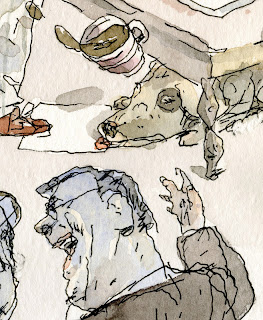Franklin McMahon, the last of the great illustrator-reporters, died last week at age 90.
McMahon worked in a bygone era when newspapers and news magazines relied on artists to add class and grace to the reportage of current events. For 50 years, McMahon went everywhere and witnessed everything on behalf of news publications such as The New York Times, The Chicago Tribune, Look, Life, Time and Sports Illustrated.
His career as a reporter began in 1955, when McMahon covered the infamous Emmett Till murder trial for Life Magazine.
 |
| Emmett Till's aged uncle points a quavering finger at his nephew's murderers |
He went on to cover the key events of the Civil Rights movement, the space program and numerous political campaigns. Unlike a camera, McMahon prioritized the essential elements of his images and conveyed his impressions, adding an important dimension.
 |
| Pope John xxiii |
 |
| The Vatican |
McMahon recalled that he was hired by publications that were "confronted with mountains of material and a need to transcend the usual dreary recitation of facts and figures." His role was to "heighten the emotional reaction to a printed piece and transmit the special flavor of a [subject]."
 |
| The Duomo, Milan |
 |
| Detail of Duomo, above |
His documentary artwork also added distinctive elements to annual reports and trade journals:
The day of the illustrator-reporter is now gone, just as the newspapers and news magazines where these pictures once appeared are in the process of disappearing. Many of the professional photographers who replaced illustrator-reporters are being replaced by internet stock photos and amateur cell phone users.
But for many years, talented illustrators such as Franklin McMahon logged a lot of miles pursuing an important craft, making great sacrifices to do quality work. The death of McMahon is a good time to remind ourselves of their contributions and honor their role.












